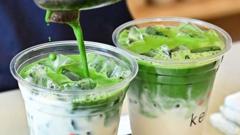Matcha, a finely ground powdered form of tea that has captivated a worldwide audience, has become a staple ingredient in a variety of products from lattes at Starbucks to desserts at Krispy Kreme. The phenomenon, buoyed by social media influencers demonstrating its versatility and health benefits, has seen the "Matcha Tok" hashtag garner tens of millions of views, notably enhancing the allure of this vibrant green tea.
As Japan experiences a surge in tourism following the pandemic—fueled by a weaker yen attracting international visitors—the demand for matcha has reached new heights. Lauren Purvis, a U.S.-based tea importer, notes that the rush has led to her customers depleting what used to be a month's supply in just a few days, with cafes requesting as much as a kilo daily to keep up with consumer interest.
However, the rise in demand is colliding with adverse weather conditions and trade policies that complicate supply chains. Japan has faced significant heatwaves that have adversely affected tea crops, and the Kyoto region, known for producing about 25% of the country’s tencha (the leaves used for matcha), has seen yields decline. The aging population of farmers, lack of new entrants into the industry, and tariffs on Japanese tea entering the U.S. have further exacerbated these challenges, driving up prices.
Retailers are responding to the intensified demand by imposing restrictions on matcha sales; some shops will sell only one tin per customer. Reports indicate that premium high-grade matcha is becoming scarce, leading to price increases of nearly 30% at places like Chazen, a tea ceremony chain in Tokyo. Amidst these shortages, there begins a movement advocating for mindful consumption of matcha rather than hoarding or claiming it for reselling purposes.
As the matcha phenomenon grows, Japan’s agricultural ministry reports that production has nearly tripled between 2010 and 2023, with green tea exports rising significantly as well. Advocates for responsible consumption suggest using lower-grade matcha for cooking instead of high-quality varieties, which can be overshadowed when mixed into lattes or other recipes.
In light of rising tariffs—from a trade agreement that applies a 15% import tax on Japanese goods entering the U.S.—matcha distributors are poised for further challenges. Purvis warns that while specialty tea represents something special in the beverage world, it is not being recognized in tariff discussions. Despite current hurdles, some industry insiders believe that the booming enthusiasm for matcha could stabilize in the coming years as the initial exuberance of global demand begins to settle.





















